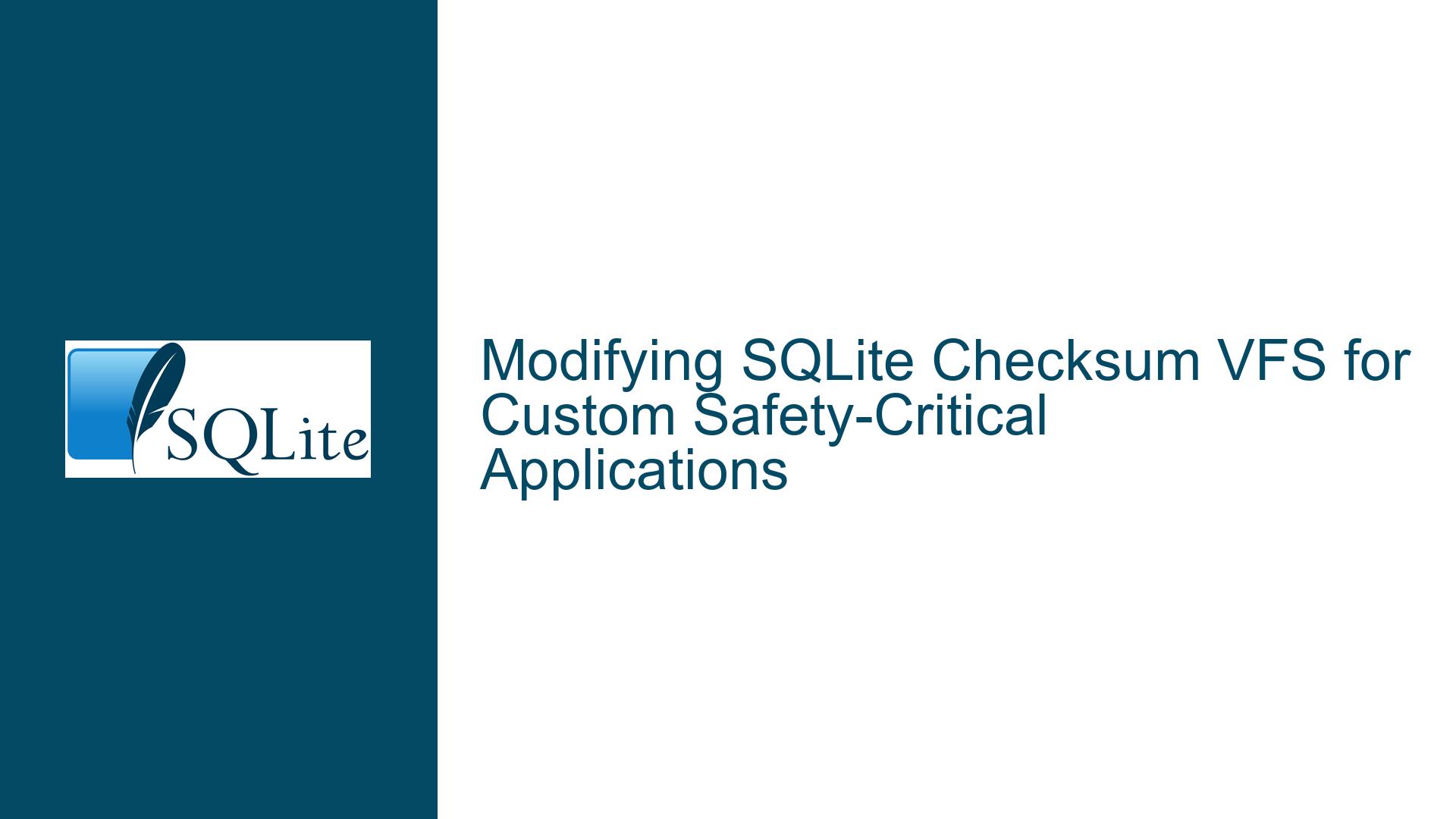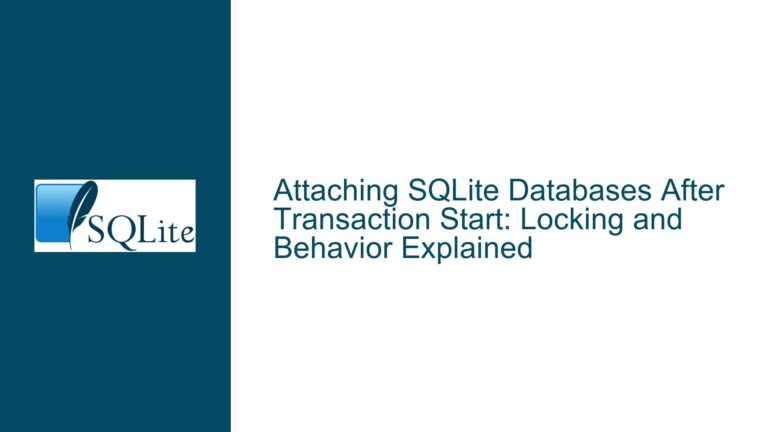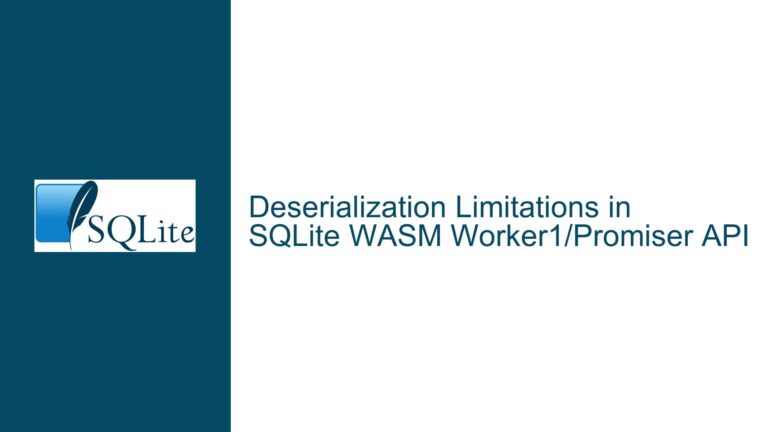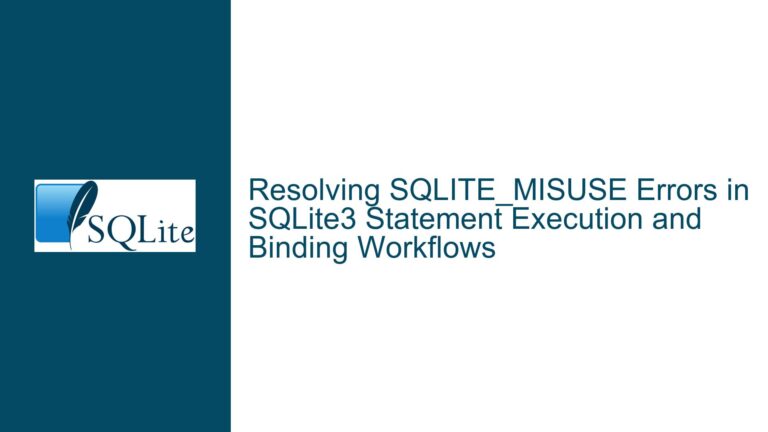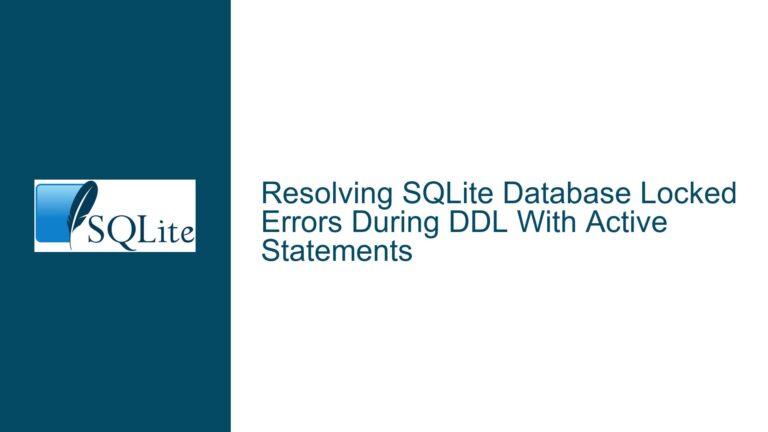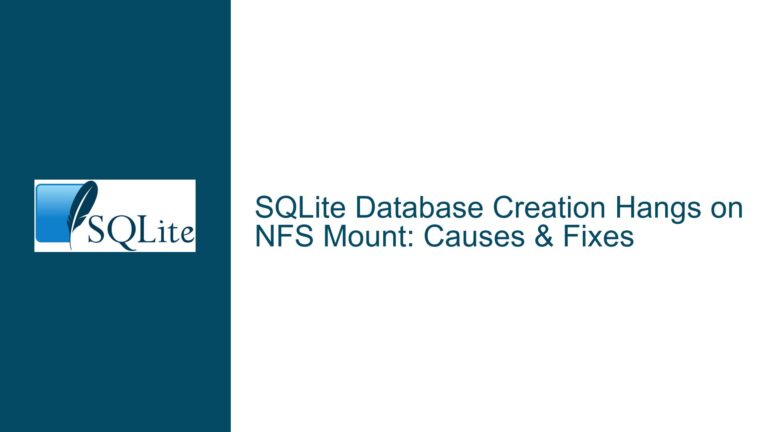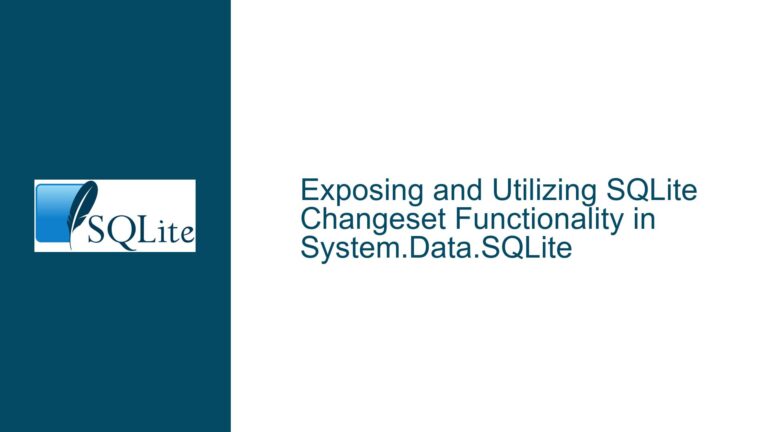Modifying SQLite Checksum VFS for Custom Safety-Critical Applications
Understanding Checksum VFS Modification Requirements in Safety-Critical Systems
SQLite’s Checksum VFS (Virtual File System) layer is designed to ensure data integrity by appending a checksum to each database page. In safety-critical systems—such as aerospace, medical devices, or industrial control systems—data corruption can have catastrophic consequences. The default 8-byte checksum algorithm provided by SQLite’s cksumvfs.c may not align with project-specific certification requirements or pre-existing standards. Modifying this layer requires a deep understanding of SQLite’s VFS architecture, checksum integration mechanics, and the constraints imposed by safety-critical certification processes.
The core challenge lies in replacing the existing 64-bit (8-byte) checksum algorithm with a custom implementation while preserving SQLite’s transactional guarantees and performance characteristics. Safety-critical systems often mandate adherence to domain-specific standards (e.g., DO-178C for avionics, ISO 26262 for automotive), which may require using a particular checksum algorithm already vetted through rigorous certification. For instance, a project might require a 128-bit checksum or a non-standard polynomial for cyclic redundancy checks (CRC) to meet traceability requirements.
Key technical dependencies include:
- VFS Layer Mechanics: SQLite interacts with storage via a pluggable VFS layer. The Checksum VFS wraps the underlying storage driver, intercepting read/write operations to compute/verify checksums.
- Checksum Storage: The default implementation reserves 8 bytes per database page for the checksum. Expanding this to 16 bytes (or another size) impacts page layout, storage efficiency, and backward compatibility.
- Algorithm Swap: The
cksmCompute()function incksumvfs.ccontains the checksum logic. Replacing it requires ensuring thread safety, atomicity during page writes, and compatibility with SQLite’s paging system.
A critical oversight in the original discussion was conflating “8-bit” and “8-byte” checksums—a distinction with significant implications for data integrity. An 8-byte checksum provides 64 bits of entropy, whereas an 8-bit checksum offers only 256 possible values, making collision detection far less reliable. This highlights the importance of precision when modifying low-level database components.
Challenges in Adapting Checksum Algorithms for Certified Systems
1. Algorithm-Certification Mismatch
Safety-critical projects often require using pre-certified algorithms to avoid re-validating third-party code. For example, a project might mandate a CRC-32C checksum due to its inclusion in a certified library, even if SQLite’s default algorithm is statistically superior. Integrating such algorithms into the Checksum VFS introduces two risks:
- Statistical Weakening: Substituting a weaker algorithm could increase the probability of undetected data corruption. For instance, a non-cryptographic hash might have higher collision rates than SQLite’s original choice.
- Performance Overheads: Certified algorithms may not be optimized for SQLite’s page-oriented I/O patterns, leading to latency spikes during intensive write operations.
2. Page Layout and Reserved Byte Management
The Checksum VFS reserves space at the end of each database page for the checksum. Modifying the reserved space from 8 to 16 bytes requires:
- Updating the
.filectrl reserve_bytesdirective to match the new checksum size. - Adjusting the page size calculations in
cksumvfs.cto avoid overwriting adjacent pages or misaligning sector boundaries. - Ensuring compatibility with SQLite’s
PRAGMA page_sizesettings. For example, a 4096-byte page with a 16-byte checksum reduces the usable space for data to 4080 bytes, which must be accounted for in schema design.
3. Atomicity and Recovery Semantics
SQLite relies on atomic page writes to maintain ACID properties. When a custom checksum fails verification during recovery (e.g., after a power loss), the VFS must correctly handle rollback scenarios without introducing false positives. A poorly implemented checksum algorithm might incorrectly flag valid pages as corrupt, leading to unnecessary database resets or application crashes.
4. Cross-Platform Consistency
The Checksum VFS must produce identical results across all platforms supported by the application. For example, endianness differences in multi-byte checksums (e.g., CRC-64) can lead to verification failures if not normalized.
Implementing and Validating a Custom Checksum VFS
Step 1: Define Checksum Requirements
- Bit Length: Confirm whether the project requires 64-bit (8-byte), 128-bit (16-byte), or another checksum size.
- Algorithm Selection: Choose an algorithm that balances collision resistance, performance, and certification status. For example, use SHA3-128 for cryptographic-strength checksums or CRC-64-ECMA for industry-standard error detection.
- Storage Overhead: Calculate the impact of reserved bytes on database size. A 16-byte checksum on a 4 KB page consumes 0.39% of space, while an 8-byte checksum uses 0.2%.
Step 2: Modify the Checksum VFS Code
Adjust Reserved Bytes:
Incksumvfs.c, update thereserve_bytesparameter to match the new checksum size:rc = pReal->pMethods->xFileControl(pReal, SQLITE_FCNTL_RESERVE_BYTES, (void*)&nReserve); // Change nReserve from 8 to 16This ensures SQLite reserves sufficient space for the checksum.
Replace
cksmCompute():
Implement the custom algorithm in thecksmComputefunction. For a 128-bit MD5 checksum:static void cksmCompute( const unsigned char *a, /* Page data */ int n, /* Number of bytes in a[] */ unsigned char *cksum /* OUT: Checksum */ ){ MD5_CTX ctx; MD5_Init(&ctx); MD5_Update(&ctx, a, n - 16); // Exclude reserved bytes MD5_Final(cksum, &ctx); }Ensure the function excludes the reserved checksum bytes from the computation.
Update Buffer Sizes:
Increase the size of buffers storing checksums. For example, changeunsigned char cksum[8]tounsigned char cksum[16].
Step 3: Validate Page Alignment and I/O Operations
- Page Size Consistency: Verify that
SQLITE_DEFAULT_PAGE_SIZEaligns with the application’s schema. UsePRAGMA page_sizeto enforce this at runtime. - Write Semantics: Test partial page writes (e.g., when the database grows incrementally) to ensure checksums are computed only over initialized bytes.
Step 4: Test Recovery and Corruption Scenarios
- Power-Loss Resilience: Use fault injection tools (e.g.,
recovery.cin SQLite’s test suite) to simulate crashes during write operations. Confirm that the database recovers without false corruption errors. - Checksum Collision Tests: Inject controlled corruptions into database pages and verify that the custom checksum detects them. For example:
// Corrupt a byte in page 5 void* pPage = sqlite3PagerGetData(pPager, 5); pPage[100] ^= 0xFF; // Flip bits
Step 5: Performance Benchmarking
- Throughput Metrics: Compare transaction rates and latency with/without the custom checksum using
sqlite3_benchmark. - Concurrency Tests: Stress-test the VFS under multi-threaded workloads to identify locking issues or memory corruption.
Step 6: Certification and Deployment
- Documentation: Provide traceability matrices linking checksum code to certification requirements.
- Static Analysis: Use tools like Coverity or Clang Analyzer to prove the absence of undefined behavior in the custom VFS.
Maintenance Considerations
- SQLite Upgrades: Rebase customizations onto new SQLite versions by monitoring changes to
cksumvfs.cand the VFS API. - Checksum Versioning: Embed a magic number in the reserved bytes to detect algorithm mismatches during database opens.
By methodically addressing these areas, developers can integrate project-specific checksum algorithms into SQLite while maintaining the robustness required for safety-critical applications.
